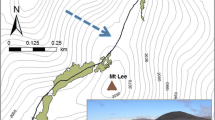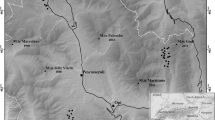Abstract
Using hierarchical Bayesian analysis, we tested the hypothesis that a perennial tussock grass, Ischaemum aristatum var. glaucum, facilitates the species diversity of vegetation and the regeneration of individual native vascular plants in Ukishima Marsh, a moist tall grassland of eastern Japan. We analyzed microscale distribution patterns of sympatric plant species in response to ground height. Both the species richness of the whole plant assemblage and the occurrence of many native vascular plants, including two endangered species, were positively correlated with ground elevation, which was directly mediated by I. aristatum var. glaucum tussocks and/or the occurrence of mosses on tussocks. Susceptibility to late spring inundation of microsites on the tussocks was significantly lower than that on bare ground. These results suggest that the facilitation by I. aristatum var. glaucum contributes to maintaining the high species richness of the marsh. Consideration of the facilitation among native vascular plants is necessary for establishing sound conservation plans of wetland vegetation.






Similar content being viewed by others
References
Akhalkatsi M, Abdaladze O, Nakhutsrishvili G, Smith WK (2006) Facilitation of seedling microsites by Rhododendron caucaskum extends the Betula litwinowii Alpine treeline, Caucasus Mountains, Republic of Georgia. Arct Antarct Alp Res 38:481–488
Bertness MD, Callaway R (1994) Positive interactions in communities. Trends Ecol Evol 9:191–193
Brooker RW, Maestre FT, Callaway RM, Lortie CL, Cavieres LA, Kunstler G, Liancourt P, Tielborger K, Travis JMJ, Anthelme F, Armas C, Coll L, Corcket E, Delzon S, Forey E, Kikvidze Z, Olofsson J, Pugnaire F, Quiroz CL, Saccone P, Schiffers K, Seifan M, Touzard B, Michalet R (2008) Facilitation in plant communities: the past, the present, and the future. J Ecol 96:18–34. doi:10.1111/j.1365-2745.2007.01295.x
Bruno JF, Stachowicz JJ, Bertness MD (2003) Inclusion of facilitation into ecological theory. Trends Ecol Evol 18:119–125
Callaway RM (1995) Positive interactions among plants. Bot Rev 61:306–349
Callaway RM (1997) Positive interactions in plant communities and the individualistic-continuum concept. Oecologia 112:143–149
Callaway RM (2007) Positive interactions and interdependence in plant communities. Springer, Berlin
Callaway RM, Pennings SC (2000) Facilitation may buffer competitive effects: indirect and diffuse interactions among salt marsh plants. Am Nat 156:416–424
Callaway RM, Kikodze D, Chiboshvili M, Khetsuriani L (2005) Unpalatable plants protect neighbors from grazing and increase plant community diversity. Ecology 86:1856–1862
Casella G, George EI (1992) Explaining the Gibbs sampler. Am Stat 46:167–174
Castro J, Zamora R, Hodar JA, Gomez JM (2002) Use of shrubs as nurse plants: a new technique for reforestation in Mediterranean mountains. Restor Ecol 10:297–305
Cavieres LA, Badano EI (2009) Do facilitative interactions increase species richness at the entire community level? J Ecol 97:1181–1191. doi:10.1111/j.1365-2745.2009.01579.x
Crain CM, Bertness ND (2005) Community impacts of a tussock sedge: is ecosystem engineering important in benign habitats? Ecology 86:2695–2704
Cressie N, Calder CA, Clark JS, Hoef JMV, Wikle CK (2009) Accounting for uncertainty in ecological analysis: the strengths and limitations of hierarchical statistical modeling. Ecol Appl 19:553–570
Ellison AM (2004) Bayesian inference in ecology. Ecol Lett 7:509–520. doi:10.1111/j.1461-0248.2004.00603.x
Ervin GN (2007) An experimental study on the facilitative effects of tussock structure among wetland plants. Wetlands 27:620–630
Fidelis A, Overbeck GE, Pillar VD, Pfadenhauer J (2009) The ecological value of Eryngium horridum in maintaining biodiversity in subtropical grasslands. Aust Ecol 34:558–566. doi:10.1111/j.1442-9993.2009.01959.x
Fogel BN, Crain CM, Bertness MD (2004) Community level engineering effects of Triglochin maritima (seaside arrowgrass) in a salt marsh in northern New England, USA. J Ecol 92:589–597
Freestone AL (2006) Facilitation drives local abundance and regional distribution of a rare plant in a harsh environment. Ecology 87:2728–2735
Gelman A, Carlin JB, Stern HS, Rubin DB (2004) Bayesian data analysis, 2nd edn. Chapman & Hall/CRC, Boca Raton
Geyer CJ (1992) Practical Markov chain Monte Carlo. Stat Sci 7:473–483
Gomez-Aparicio L, Zamora R, Gomez JM, Hodar JA, Castro J, Baraza E (2004) Applying plant facilitation to forest restoration: a meta-analysis of the use of shrubs as nurse plants. Ecol Appl 14:1128–1138
Groeneveld EVG, Masse A, Rochefort L (2007) Polytrichum strictum as a nurse-plant in peatland restoration. Restor Ecol 15:709–719
Hoeting JA (2009) The importance of accounting for spatial and temporal correlation in analyses of ecological data. Ecol Appl 19:574–577
Ibaraki Prefecture (1997) Red data book of wild plants in Ibaraki Prefecture, Japan. Ibaraki Prefecture (in Japanese)
King EG, Stanton ML (2008) Facilitative effects of Aloe shrubs on grass establishment, growth, and reproduction in degraded Kenyan rangelands: implications for restoration. Restor Ecol 16:464–474. doi:10.1111/j.1526-100X.2007.00310.x
Lunn DJ, Thomas A, Best N, Spiegelhalter D (2000) WinBUGS—a Bayesian modelling framework: concepts, structure, and extensibility. Stat Comput 10:325–337
Nakada T, Shiozawa S, Yoshida K (2009) Water cycle and water level fluctuations in Myoginohana floodplain located at lakefront of Kasumigaura. J Jpn Soc Hydrol Water Resour 22:456–465 (in Japanese with English summary)
Nishihiro J, Washitani I (2009) Quantitative evaluation of water-level effects on “regeneration safe-sites” for lakeshore plants in Lake Kasumigaura, Japan. Lake Reserv Manag 25:217–223. doi:10.1080/07438140902938332
Nishihiro J, Araki S, Fujiwara N, Washitani I (2004a) Germination characteristics of lakeshore plants under an artificially stabilized water regime. Aquat Bot 79:333–343. doi:10.1016/j.aquabot.2004.05.005
Nishihiro J, Miyawaki S, Fujiwara N, Washitani I (2004b) Regeneration failure of lakeshore plants under an artificially altered water regime. Ecol Res 19:613–623
Nozoe K, Nishihiro J, Hotes S, Washitani I (2010) Importance of Ischaemum aristatum var. glaucum as an indicator of plant species richness in Myoginohana Marsh, Lake Kasumigaura, Japan. Jpn J Conserv Ecol 15:281–290 (in Japanese with English summary)
Ogle K (2009) Hierarchical Bayesian statistics: merging experimental and modeling approaches in ecology. Ecol Appl 19:577–581
Peach M, Zedler JB (2006) How tussocks structure sedge meadow vegetation. Wetlands 26:322–335
Peterson JE, Baldwin AH (2004) Seedling emergence from seed banks of tidal freshwater wetlands: response to inundation and sedimentation. Aquat Bot 78:243–254. doi:10.1016/j.aquabot.2003.10.005
R Development Core Team (2009) R: a language and environment for statistical computing. R Foundation for Statistical Computing, Vienna, Austria. ISBN 3-900051-07-0. http://www.R-project.org
Richard F, Selosse MA, Gardes M (2009) Facilitated establishment of Quercus ilex in shrub-dominated communities within a Mediterranean ecosystem: do mycorrhizal partners matter? FEMS Microbiol Ecol 68:14–24. doi:10.1111/j.1574-6941.2009.00646.x
Tewksbury JJ, Lloyd JD (2001) Positive interactions under nurse-plants: spatial scale, stress gradients and benefactor size. Oecologia 127:425–434
Tirado R, Pugnaire FI (2005) Community structure and positive interactions in constraining environments. Oikos 111:437–444
Verdu M, Valiente-Banuet A (2008) The nested assembly of plant facilitation networks prevents species extinctions. Am Nat 172:751–760. doi:10.1086/593003
Washitani I, Tang Y (1991) Microsite variation in light availability and seedling growth of Quercus serrata in a temperate pine forest. Ecol Res 6:305–316
Yabe K (1985) Distribution and formation of tussocks in Mobara-Yatsumi Marsh. Jpn J Ecol 35:183–192
Acknowledgments
This research was supported by the River Fund in charge of the Foundation of River and Watershed Environment Management and a Grant-in-Aid for Young Scientists (B) 19710198 in charge of the Ministry of Education, Culture, Sports, Science, and Technology, Japan, to J. Nishihiro.
Author information
Authors and Affiliations
Corresponding author
About this article
Cite this article
Wang, Z., Nishihiro, J. & Washitani, I. Facilitation of plant species richness and endangered species by a tussock grass in a moist tall grassland revealed using hierarchical Bayesian analysis. Ecol Res 26, 1103–1111 (2011). https://doi.org/10.1007/s11284-011-0862-z
Received:
Accepted:
Published:
Issue Date:
DOI: https://doi.org/10.1007/s11284-011-0862-z




